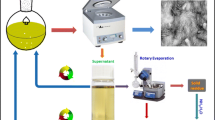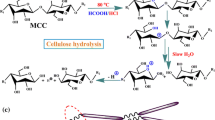Abstract
The production of cellulose nanocrystals (CNCs) from vegetable fibres and residues has been intensely investigated due to the properties of high crystallinity and specific surface area of these nanofillers. The most common method of obtaining CNCs is by acid hydrolysis with inorganic acids; however, this method can lead to uncontrolled depolymerisation of the cellulose. Thus, this article examines the use of Lewis acids (FeSO4, Fe2(SO4)3 and FeCl3) as co-catalysts in the acid hydrolysis process and compares their impact on the yield, reduction of particle size and crystallinity index of the CNCs. The results show that the presence of Fe2(SO4)3 and FeCl3 improved the yield (50 and 27%, respectively) and decreased the particle size (632 and 66 nm, respectively) of the CNCs obtained in the hydrolysis process. On the other hand, the crystallinity index values were similar to that of microcrystalline cellulose (MCC), which was probably due to the severe conditions of the hydrolysis process that was used. The scanning transmission microscopy (STEM) images showed a spherical morphology for the CNCs obtained by both inorganic acid and Lewis acids; once again, this was probably due to the severe hydrolysis conditions. Thus, the presence of Lewis acids in the hydrolysis process makes it more efficient because it increases the efficiency of the hydrolysis in a less corrosive environment and with less probability of depolymerisation of the cellulose.





Similar content being viewed by others
References
Araki J, Wada M, Kuga S, Okano T (1998) Flow properties of microcrystalline cellulose suspension prepared by acid treatment of native cellulose. Colloid Surface A 142(1):75–82
Azrina ZZ, Beg MDH, Rosli MY et al (2017) Spherical nanocrystalline cellulose (NCC) from oil palm empty fruit bunch pulp via ultrasound assisted hydrolysis. Carbohyd Polym 162:115–120
Beck-Candanedo S, Roman M, Gray DG (2005) Effect of reaction conditions on the properties and behavior of wood cellulose nanocrystal suspensions. Biomacromolecules 6(2):1048–1054
Bondeson D, Mathew A, Oksman K (2006) Optimization of the isolation of nanocrystals from microcrystalline cellulose by acid hydrolysis. Cellulose 13(2):171–180
Chen Y, Liu C, Chang PR, Cao X, Anderson DP (2009) Bionanocomposites based on pea starch and cellulose nanowhiskers hydrolyzed from pea hull fibre: effect of hydrolysis time. Carbohyd Polym 76(4):607–615
Chen W, Yu H, Liu Y, Chen P, Zhang M, Hai Y (2011) Individualization of cellulose nanofibers from wood using high-intensity ultrasonication combined with chemical pretreatments. Carbohyd Polym 83(4):1804–1811
Chen YW, Lee HV, Hamid SBA (2016) A response surface methodology study: effects of trivalent Cr3+ metal ion-catalyzed hydrolysis on nanocellulose crystallinity and yield. BioResources 11(2):4645–4662.a
Ditzel FI, Prestes E, Carvalho BM, Demiate IM, Pinheiro LA (2017) Nanocrystalline cellulose extracted from pine wood and corncob. Carbohyd Polym 157:1577–1585
Dufresne A (2013) Nanocellulose: a new ageless bionanomaterial. Mater Today 16(6):220–227
Fahma F, Iwamoto S, Hori N, Iwata T, Takemura A (2010) Isolation, preparation, and characterization of nanofibers from oil palm empty-fruit-bunch (OPEFB). Cellulose 17(5):977–985
Habibi Y, Lucia LA, Rojas OJ (2010) Cellulose nanocrystals: chemistry, self-assembly, and applications. Chem Rev 110(6):3479–3500
Hamid SBA, Chowdhury ZZ, Karim MZ (2014) Catalytic extraction of microcrystalline cellulose (MCC) from Elaeis guineensis using central composite design (CCD). BioResources 9(4):7403–7426
Kamireddy SR, Li J, Tucker M, Degenstei J, Ji Y (2013) Effects and mechanism of metal chloride salts on pretreatment and enzymatic digestibility of corn stover. Ind Eng Chem Res 52(5):1775–1782
Karim Z, Afrin S (2015) Nanocellulose as novel supportive functional material for growth and development of cells. Cell Dev Biol 4(1000154):2
Lee HV, Hamid SBA, Zain SK (2014) Conversion of lignocellulosic biomass to nanocellulose: structure and chemical process. Sci World J 2014:1–20
Li J, Xiu H, Zhang M, Wang H, Ren Y, Ji Y (2013) Enhancement of cellulose acid hydrolysis selectivity using metal ion catalysts. Curr Org Chem 17(15):1617–1623
Li J, Zhang X, Zhang M, Xiu H, He H (2015) Ultrasonic enhance acid hydrolysis selectivity of cellulose with HCl-FeCl3 as catalyst. Carbohydr Polym 117:917–922
Liu L, Sun J, Cai C, Wang S, Pei H, Zhang J (2009) Corn stover pretreatment by inorganic salts and its effects on hemicellulose and cellulose degradation. Bioresour Technol 100(23):5865–5871
Liu J, Wang Q, Wang S, Zou D, Sonomoto K (2012) Utilisation of microwave-NaOH pretreatment technology to improve performance and L-lactic acid yield from vinasse. Biosyst Eng 112(1):6–13
Liu Y, Wang H, Yu G, Yu Q, Li B, Mu X (2014) A novel approach for the preparation of nanocrystalline cellulose by using phosphotungstic acid. Carbohyd Polym 110:415–422
López-Linares JC, Romero I, Moya M, Cara C, Ruiz E, Castro E (2013) Pretreatment of olive tree biomass with FeCl3 prior enzymatic hydrolysis. Bioresour Technol 128:180–187
Lu Q, Tang L, Lin F, Wang S, Chen Y, Chen X, Huang B (2014) Preparation and characterization of cellulose nanocrystals via ultrasonication-assisted FeCl 3-catalyzed hydrolysis. Cellulose 21(5):3497–3506
Mandal A, Chakrabarty D (2011) Isolation of nanocellulose from waste sugarcane bagasse (SCB) and its characterization. Carbohyd Polym 86(3):1291–1299
Melikoğlu AY, Bilek SE, Cesur S (2019) Optimum alkaline treatment parameters for the extraction of cellulose and production of cellulose nanocrystals from apple pomace. Carbohydr Polym 215:330–337
Mirhosseini H, Tan CP, Hamid NS, Yusof S (2008) Effect of Arabic gum, xanthan gum and orange oil contents on ζ-potential, conductivity, stability, size index and pH of orange beverage emulsion. Colloid Surface A 315(1–3):47–56
Morais JPS, Rosa MDF, de Souza Filho MDSM et al (2013) Extraction and characterization of nanocellulose structures from raw cotton linter. Carbohyd Polym 91:229–235
Morán JI, Alvarez VA, Cyras VP, Vázquez A (2008) Extraction of cellulose and preparation of nanocellulose from sisal fibers. Cellulose 15(1):149–159
Neto WPF, Silvério HA, Dantas NO, Pasquini D (2013) Extraction and characterization of cellulose nanocrystals from agro-industrial residue–Soy hulls. Ind Crop Prod 42:480–488
Nishiyama Y, Sugiyama J, Chanzy H, Langan P (2003) Crystal structure and hydrogen bonding system in cellulose Iα from synchrotron X-ray and neutron fiber diffraction. J Am Chem Soc 125(47):14300–14306
Peng L, Lin L, Zhang J et al (2010) Catalytic conversion of cellulose to levulinic acid by metal chlorides. Molecules 15(8):5258–5272
Pereira ALS, do Nascimento DM, Morais JPS et al (2014) Improvement of polyvinyl alcohol properties by adding nanocrystalline cellulose isolated from banana pseudostems. Carbohyd Polym 112:165–172
Sadeghifar H, Filpponen I, Clarke SP, Brougham DF, Argyropoulos DS (2011) Production of cellulose nanocrystals using hydrobromic acid and click reactions on their surface. J Mater Sci 46(22):7344–7355
Satyamurthy P, Vigneshwaran N (2013) A novel process for synthesis of spherical nanocellulose by controlled hydrolysis of microcrystalline cellulose using anaerobic microbial consortium. Enzym Microb Technol 52(1):20–25
Segal LGJMA, Creely JJ, Martin AE Jr, Conrad CM (1959) An empirical method for estimating the degree of crystallinity of native cellulose using the X-ray diffractometer. Text Res J 29(10):786–794
Shankar S, Rhim JW (2016) Preparation of nanocellulose from micro-crystalline cellulose: the effect on the performance and properties of agar-based composite films. Carbohyd Polym 135:18–26
Silva DJ, D’almeida MLO (2009) Cellulose nanocrystals. O Papel 70(7):34–52
Singha B, Naiya TK, Kumar BA, Das SK (2011) Cr (VI) ions removal from aqueous solutions using natural adsorbents–FTIR studies. J Environ Prot 2(06):729
Suppiah DD, Johan MR (2019) Catalytic conversion of microcrystalline cellulose to nanocellulose using iron oxide catalysts. Indian J Chem A 58:265–270
Wang N, Ding E, Cheng R (2007) Thermal degradation behaviors of spherical cellulose nanocrystals with sulfate groups. Polymer 48(12):3486–3493
Xiong R, Zhang X, Tian D et al (2012) Comparing microcrystalline with spherical nanocrystalline cellulose from waste cotton fabrics. Cellulose 19:1189–1198
Yahya MB, Lee HV, Hamid SBA (2015) Preparation of nanocellulose via transition metal salt-catalyzed hydrolysis pathway. BioResources 10(4):7627–7639
Yahya M, Chen YW, Lee HV, Hassan WHW (2018) Reuse of selected lignocellulosic and processed biomasses as sustainable sources for the fabrication of nanocellulose via Ni (II)-catalyzed hydrolysis approach: a comparative study. J Polym Environ 26(7):2825–2844
Zhang Y, Li Q, Su J, Lin Y, Huang Z, Lu Y, Sun G, Yang M, Huang A, Hu H, Zhu Y (2015) A green and efficient technology for the degradation of cellulosic materials: structure changes and enhanced enzymatic hydrolysis of natural cellulose pretreated by synergistic interaction of mechanical activation and metal salt. Bioresour Technol 177:176–181
Zhao J, Zhang H, Zheng R, Lin Z, Huang H (2011) The enhancement of pretreatment and enzymatic hydrolysis of corn stover by FeSO4 pretreatment. Biochem Eng J 56(3):158–164
Funding
This study was funded by the Conselho Nacional de Desenvolvimento Científico (CNPq, grant nos. 311851/2014-2 and 313002/2017-7)and Coordenação de Aperfeiçoamento de Pessoal de Nível Superior (CAPES).
Author information
Authors and Affiliations
Corresponding author
Ethics declarations
Conflict of interest
The authors declare that they have no conflict of interest.
Additional information
Publisher’s note
Springer Nature remains neutral with regard to jurisdictional claims in published maps and institutional affiliations.
Rights and permissions
About this article
Cite this article
Kishimoto, C.T.M., Moerschbacher, L., Prestes, R.A. et al. Preparation of nanocellulose by hydrolysis catalysedusing salts with different Fe valency. J Nanopart Res 22, 200 (2020). https://doi.org/10.1007/s11051-020-04928-1
Received:
Accepted:
Published:
DOI: https://doi.org/10.1007/s11051-020-04928-1




